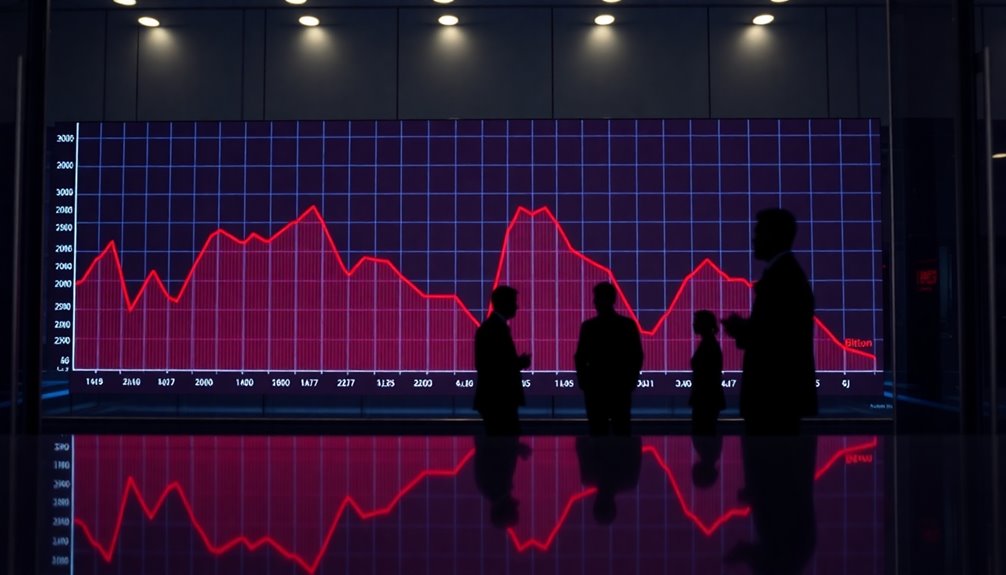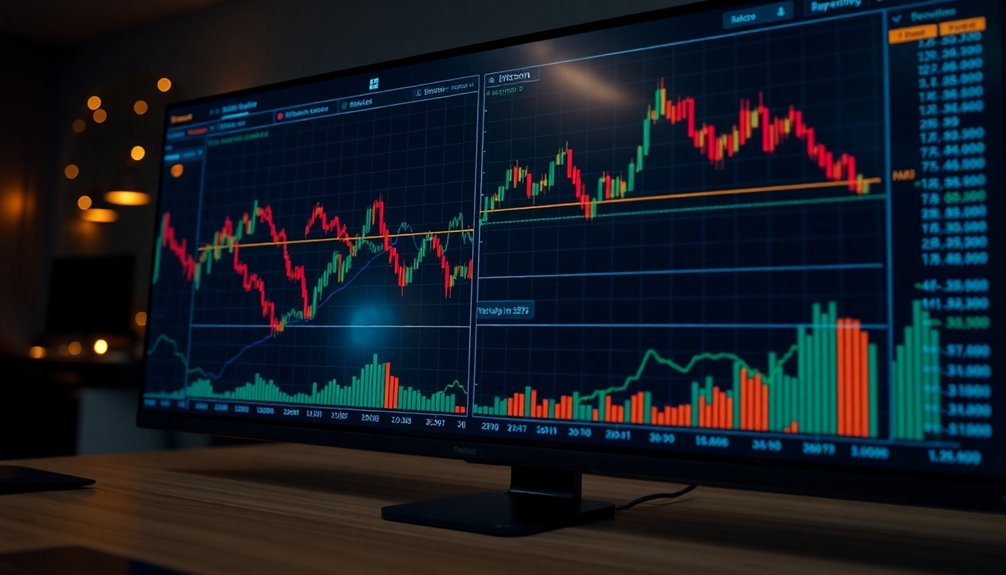If you're looking at Bitcoin's negative netflow on Binance, it shows a noteworthy trend of increasing withdrawals over deposits. This signals a strong accumulation by long-term holders, which often leads to bullish sentiment and potential price increases. As supply on exchanges decreases, there's upward pressure on Bitcoin's price, especially with institutional investors showing interest. The recent $20 million in net outflows reflects shifting investor behavior, hinting at confidence in future growth. These factors create an environment ripe for buying opportunities, and there's much more to uncover about the dynamics at play.
Key Takeaways
- Negative netflow on Binance indicates increased Bitcoin withdrawals, suggesting accumulating demand and potential upward price pressure.
- Reduced supply on exchanges due to negative netflow correlates with rising Bitcoin prices and bullish market sentiment.
- Sustained negative netflows may lead to higher price volatility, creating buying opportunities during demand spikes.
- Institutional interest and regulatory advancements contribute to the positive implications of negative netflow in the Bitcoin market.
- Historical trends show that negative netflow periods often precede significant price increases, supporting bullish forecasts for Bitcoin.
Understanding Exchange Netflow

When you look at Exchange Netflow, you're essentially examining the balance of cryptocurrency movement in and out of exchanges. Netflow is calculated by subtracting outflows from inflows, revealing whether more coins are being deposited or withdrawn.
A positive Netflow indicates that more coins are flowing into the exchange, hinting at potential selling pressure. Conversely, a negative Netflow suggests that more coins are being withdrawn, pointing to possible buying pressure or accumulation. Regular monitoring of Netflow data can enhance trading effectiveness.
You can visualize these movements with color-coded bubbles, where red signifies inflows exceeding outflows and green represents the opposite.
Recent Trends in Binance Netflow

As Binance's netflow turned negative on January 6, 2025, it signaled a significant shift in market dynamics, indicating that more Bitcoin is being withdrawn than deposited on the exchange.
This trend often precedes upward price movements due to a reduced supply on exchanges, which can lead to a tighter market. You might notice that the negative netflow reflects investor confidence and a preference for long-term holding strategies. Moreover, whale movements within the top transactions significantly impact netflow metrics and market sentiment.
Recent data shows that high net outflows typically correlate with rising demand, reinforcing the notion that current accumulation patterns align with past bullish trends. Historical data shows that similar negative netflow periods correlate with future price increases, suggesting that current accumulation patterns align with past bullish trends.
Market Implications of Negative Netflow

Negative netflow not only reflects a shift in market sentiment but also suggests potential implications for Bitcoin's price dynamics.
When you see more Bitcoin being withdrawn than deposited, it points to accumulation by long-term holders who believe in Bitcoin's future. This trend often correlates with rising prices due to a reduced supply on exchanges. Historically, decreasing exchange supply has been linked to upward price momentum, which adds to the bullish sentiment surrounding Bitcoin.
As liquidity decreases, you might notice increased price volatility, particularly if demand spikes. Historical patterns show that sustained negative net flows can precede bullish movements.
Moreover, tighter market conditions created by these outflows can lead to price surges. Keeping an eye on these developments can help you identify buying opportunities and better navigate the market's complexities.
Investor Behavior and Withdrawal Patterns

Understanding investor behavior and withdrawal patterns is crucial for navigating the Bitcoin market effectively. Many investors are driven by both intrinsic motivations, like self-efficacy, and extrinsic factors, such as peer acceptance.
As you pursue high returns, you might also consider Bitcoin as a hedge against traditional market fluctuations. The current negative netflow indicates that holders are accumulating Bitcoin, transferring it to private wallets for long-term retention. This trend aligns with the growing popularity of non-custodial wallets, such as Zengo, which offer enhanced security for storing digital assets.
Withdrawal limits vary based on verification levels; basic users can withdraw up to 0.06 BTC daily, while fully verified ones can access up to 100 BTC.
Keep in mind that network traffic can affect withdrawal times, with Bitcoin transactions typically taking 10-30 minutes. Understanding these patterns helps you make informed decisions in a volatile market.
Economic and Regulatory Influences

Economic and regulatory influences play a pivotal role in shaping the Bitcoin market. When demand outstrips supply, as indicated by negative netflow from Binance, you might see upward price pressure. Increased outflows signal long-term holding, which reduces immediate selling and supports price increases. Recent net outflows in the BTC market of approximately $20 million suggest a shift in investor sentiment. Additionally, the average time to mine 1 Bitcoin is approximately 10 minutes, which can impact market dynamics as miners adjust their strategies based on profitability.
Global economic events, like interest rate changes, can also affect your confidence in Bitcoin, especially during downturns. Regulatory approvals, such as Bitcoin spot ETFs, boost investor sentiment, while crackdowns can lead to volatility. Furthermore, regulatory frameworks in regions like Kazakhstan are increasingly affecting mining operations, which may influence supply and demand in the market. Additionally, Bitcoin's correlation with assets like gold means inflationary pressures could drive you to invest more in it. Ultimately, clear regulations create a stable environment, while ambiguity can deter investment and negatively impact market sentiment.
Technical Analysis of Netflow Metrics

Netflow metrics serve as a crucial tool in assessing the Bitcoin market's health and investor sentiment. By calculating exchange netflow, you can determine the difference between Bitcoin inflows and outflows.
The 14-day Simple Moving Average (SMA14) of netflow highlights short-term trends, while transaction counts help gauge market activity. Positive netflow often signals selling pressure, whereas negative netflow indicates accumulation, potentially foreshadowing bullish trends. Recent data shows that a negative Netflow value of -5,407 BTC on January 6, 2025, reflects this accumulation trend.
Increased inflows or outflows can suggest volatility, impacting your trading strategy. Historical patterns reveal that negative netflow frequently precedes upward price movements and reduces immediate selling capacity, making it an essential metric for understanding market dynamics and investor behavior.
Keeping an eye on these trends can guide your investment decisions effectively.
Fintech and Startup Considerations

As you navigate the dynamic world of fintech startups, it's essential to consider a range of factors that can significantly influence your success.
Focus on building a strong team, including developers, financial analysts, and regulatory compliance officers, to ensure your platform's viability. Conduct thorough market research to identify saturation levels, trending features, and user pain points. This insight will help shape your product roadmap. Additionally, understanding regulatory environments early in your process will help you design compliant solutions that meet market demands.
Develop a solid business strategy by identifying your target audience and diversifying revenue streams. Pay attention to compliance requirements relevant to your chosen jurisdiction, and ensure your payment infrastructure is robust.
Finally, implement effective risk management strategies to navigate the volatile landscape and evaluate potential partnerships with financial institutions to expand your client base.
Future Outlook for Bitcoin Prices

The future outlook for Bitcoin prices appears promising, with experts predicting significant growth over the next few years. By 2025, prices could range between $75,550 and $125,000, with some forecasts stretching up to $200,000.
This bullish sentiment stems from Bitcoin's limited supply of 21 million coins, most of which have already been mined. The anticipation surrounding Bitcoin halvings and increasing demand from adoption further supports these predictions. Additionally, institutional crypto adoption plays a significant role in driving up the price trajectory for Bitcoin.
Bullish chart patterns, such as the giant cup and handle, and a recent breakout suggest upward momentum. Additionally, strong inflows into Bitcoin ETFs and regulatory advancements could enhance price stability.
Frequently Asked Questions
How Do Individual Investors Interpret Negative Netflow Signals?
When you see negative netflow signals, you might interpret them as a sign of increasing investor confidence in Bitcoin.
It suggests that more people are withdrawing their assets for long-term holding rather than trading, indicating bullish sentiment.
You might feel encouraged to accumulate more, believing that reduced supply on exchanges could lead to price increases.
Ultimately, this trend often leads you to anticipate potential upward price movements in the market.
What Are the Historical Trends of Bitcoin Netflow on Binance?
When you look at historical trends of Bitcoin netflow on Binance, you'll notice that negative netflow often indicates that more Bitcoin is being withdrawn than deposited.
This pattern suggests that investors are accumulating Bitcoin for long-term holding rather than trading.
Over time, negative netflow has frequently preceded price increases, as reduced supply on exchanges leads to potential upward pressure on prices.
You might find that this trend serves as a bullish sentiment indicator.
How Do Whales Impact Bitcoin Netflow Metrics?
Whales significantly impact Bitcoin netflow metrics by executing large transactions that sway the overall flow of Bitcoin into and out of exchanges.
When you see negative netflow, it often means whales are accumulating by withdrawing Bitcoin to hold long-term.
Conversely, positive netflow suggests they're depositing Bitcoin for selling, which can create bearish pressure.
Keeping an eye on these movements helps you gauge market sentiment and make informed trading decisions.
What Tools Can Track Bitcoin Netflow Changes Effectively?
To track Bitcoin netflow changes effectively, you can use tools like CryptoQuant, which analyzes the net amount entering or exiting exchanges. Its 14-day simple moving average helps you spot trends.
Alternatively, platforms like CryptoMeter.io visualize liquidity shifts, giving you broader market insights.
For a more customized approach, consider using APIs to extract real-time data from exchanges like Binance, allowing you to set personalized metrics and alerts based on netflow changes.
How Does Bitcoin's Supply Affect Its Long-Term Price Stability?
Bitcoin's limited supply greatly affects its long-term price stability. Since only 21 million coins will ever exist, scarcity drives demand, especially during economic uncertainty.
As block rewards halve, new supply decreases, reducing the potential for sharp sell-offs. With many coins held by long-term investors, you're likely to see steadier price increases.
This scarcity creates a strong foundation, making Bitcoin not just a speculative asset but a reliable store of value over time.
Conclusion
In conclusion, the recent negative netflow on Binance signals a shift in market dynamics that you can't ignore. As investors withdraw their Bitcoin, it reflects growing caution and uncertainty. This trend, influenced by economic and regulatory factors, could have significant implications for future price movements. Staying informed about these changes will help you navigate the crypto landscape effectively. Keep an eye on netflow metrics, as they can provide crucial insights into market sentiment and potential opportunities.









